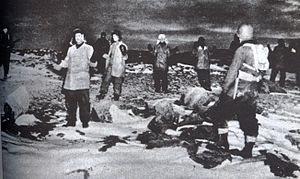American occupation of Greenland
| History of Greenland during World War II | |||||||
|---|---|---|---|---|---|---|---|
| Part of World War II | |||||||
 Members of a German weather station surrender to US forces (October 1944) |
|||||||
|
|||||||
| Belligerents | |||||||
|
|
|
||||||
| Commanders and leaders | |||||||
|
|
|
||||||
| Strength | |||||||
|
Greenland: 15 men Denmark: 1 patrol ship 1 survey ship United States: 44+ ships |
Unknown | ||||||
| Casualties and losses | |||||||
| 3 killed 4 wounded 1 police station destroyed |
1+ killed 70+ captured 1 transport ship captured All weather stations withdrawn or destroyed |
||||||
In 1940, Greenland was a Danish colony. The fall of Denmark to German invasion in April 1940 left Greenland an unoccupied territory of an occupied nation, but under threat of seizure by Britain or Canada. To forestall this, the United States acted to guarantee Greenland's position. However, with the entrance of the United States into the war in December 1941, Greenland became a combatant. During 1941-45 the United States established numerous and extensive facilities for air and sea traffic in Greenland, as well as radio beacons, radio stations, weather stations, ports, depots, artillery posts, and search-and-rescue stations. The U.S. Coast Guard also provided a considerable portion of the civilian resupply task up and down both coasts. Economically, Greenland traded successfully with the United States, Canada, and Portugal, which, supplemented by the cryolite exports, caused a reanimation and permanent realignment of the island's economy.
Before the war, Greenland was a tightly controlled colony of Denmark, otherwise closed off to the world. After the Invasion of Denmark on 9 April 1940, Greenland was left on its own, because the Royal Navy seized any ships arriving from Axis-controlled Europe. Britain and Canada initially laid plans to occupy points of interest on the island, but the United States, still neutral, firmly rejected "third party" intervention there. The sheriffs ("landsfogeder") of South and North Greenland, Eske Brun and Aksel Svane, invoking the emergency clause of a 1925 law specifying how Greenland was ruled, declared Greenland a self-ruling territory, believing this to be in the best interests of the colony as Denmark was occupied by Germany. This step was taken in coordination with the Danish envoy to Washington D.C., Henrik de Kauffmann, and the U.S. State Department, and comported with the U.S. declaration of 1920 that no third nation would necessarily be accepted as a sovereign in Greenland. This diplomatic stance was seen as an extension of the Monroe Doctrine.
...
Wikipedia
